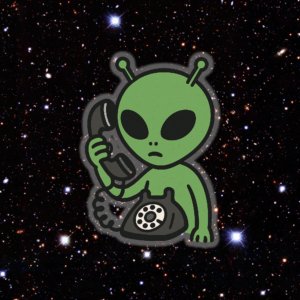 Many of us are familiar with the term SETI (the Search for Extra Terrestrial Intelligence), which is the “diverse efforts and scientific projects intended to detect extraterrestrial signals, or any evidence of intelligent life beyond Earth.” (Wikipedia) There is a very common assumption that some intelligent life must exist in the universe. Although there is zero evidence to date, people point to the nearly incomprehensible size of the known universe and reason that if life evolved on Earth, there must be parallel developments elsewhere.
Many of us are familiar with the term SETI (the Search for Extra Terrestrial Intelligence), which is the “diverse efforts and scientific projects intended to detect extraterrestrial signals, or any evidence of intelligent life beyond Earth.” (Wikipedia) There is a very common assumption that some intelligent life must exist in the universe. Although there is zero evidence to date, people point to the nearly incomprehensible size of the known universe and reason that if life evolved on Earth, there must be parallel developments elsewhere.
You can use the Drake Equation to estimate how much life there, though its inputs are entirely surmised. And its results give rise to the Fermi Paradox.
So is there life elsewhere? The only thing that can be said is “probably” if we’re being honest, but it just seems so obvious.
Hence, SETI.
Which leads to an interesting ethical question.
Independence Day
Recently I was fooling around on Netflix and stumbled across Battleship, a 2012 movie based on…well, yes, the board game. It’s by no means great cinema for the ages, but it’s a fun action movie to watch while you’re doing something else on your laptop. In the movie, Earth’s messages to outer space trying to find extra-terrestrial intelligence result in contact of the worst sort: an aggressive, violent alien invasion. It uses the common trope of “alien life visits and it’s not friendly,” much like Independence Day, War of the Worlds, Cloverfield, and others.
This kind of “first contact” is certainly possible. Famed physicist Stephen Hawking felt that it was not just possible, but probable, referring to our own history. Indeed, looking at my fellow humans, I often think that if we humans were the ones who made first contact with another less-advanced species, we’d be the enslaving aliens.
It’s also possible that any aliens who visit would be friendly, wanting to reach out and uplift us. But it’s impossible to know. Some SETI proponents feel that any species advanced far enough for interstellar travel would have developed societal norms far beyond the desire for aggressive warfare, but that is a mighty thin conjecture. Indeed, it’s entirely conjecture since we do not fully understand our own social evolution, much less that of some hypothetical alien race.
Not Just Listening
Many people think that scientists are merely listening to the stars, trying to find signals that would indicate alien life. If your only orientation to the concept of SETI is SETI@Home, then this is a logical perception.
But in fact, we have made multiple, repeated attempts to send signals to space. Some examples:
- The Arecibo Message (1974). A 1,679 digital message designed by Frank Drake and Carl Sagan was beamed to globular cluster M13. This was a purely theoretical exercise, since by the time the message arrives in 25,000 years, everything in M13 will have long since moved.
- Cosmic Call I (1999) and II (2003). This message was sent from the Evpatoria Planetary Radar in Ukraine to nearby Sun-like stars, with an ETA of 50 years.
- Teen Age Message (2001). Also sent from Ukraine, this was sent to six Sun-lie stars that are 40-70 light years away.
- The Lone Signal Project (2013). Sent from Jamesburg Earth Station in California, this message went to Gliese 526 (17.6 light-years away).
Perhaps most disturbingly, the Arecibo Observatory beamed 10,000 Twitter messages towards the source of the. Wow! Signal in 2012. That has to be some form of social media imperialism.
There are also the Pioneer Plaques aboard the Pioneer 10 and Pioneer 11 space probes, and the Voyager Golden Records (1977) aboard Voyager 1 and Voyager 2, those these are not designed as attempts to contact alien life per se.
Is This Ethical?
If there was a non-zero chance that your activities could lead to the destruction of all humanity, is it ethical to undertake those activities?
Here, the chance certainly is non-zero. How close to zero is entirely conjecture. So fundamentally the question is: what gives a small group of scientists the right to roll the dice on the fate of humanity?
Sure, there are tangible benefits. Building these kinds of systems requires developing scientific and engineering prowess. And there are many theoretical benefits. Perhaps the first species we contact are the Vulcans. But they may also be the Klingons.
Counterpoint: Dark Forests
One of the big questions to ponder is the Fermi Paradox, which essentially ask “why are we alone?” With all these billions of potential life-bearing planets on billings of stars in billions of galaxies, why haven’t we crossed paths with another sentient species?
There are various possible explanations, but one is the Dark Forest Hypothesis. This conjectures that there are many species that could make contact, but all species come to the conclusion that it’s safer not to do so, given that contact might be hostile. In this scenario, the universe is teeming with life but it’s afraid to talk with each other, because every civilization comes to the same game theory conclusion: communication comes with possible gains, but also possible self-destruction, and the latter with always outweigh the latter.
Perhaps we’re just a victim of our own science fiction.























Leave a Reply